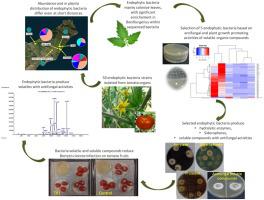当前位置:
X-MOL 学术
›
Postharvest Biol. Technol.
›
论文详情
Our official English website, www.x-mol.net, welcomes your
feedback! (Note: you will need to create a separate account there.)
Activity assessment of tomato endophytic bacteria bioactive compounds for the postharvest biocontrol of Botrytis cinerea
Postharvest Biology and Technology ( IF 6.4 ) Pub Date : 2021-02-01 , DOI: 10.1016/j.postharvbio.2020.111389 Manel Chaouachi , Takwa Marzouk , Selim Jallouli , Salem Elkahoui , Laurent Gentzbittel , Cécile Ben , Naceur Djébali
Postharvest Biology and Technology ( IF 6.4 ) Pub Date : 2021-02-01 , DOI: 10.1016/j.postharvbio.2020.111389 Manel Chaouachi , Takwa Marzouk , Selim Jallouli , Salem Elkahoui , Laurent Gentzbittel , Cécile Ben , Naceur Djébali

|
Abstract Botrytis cinerea is one of the most important postharvest fungal pathogens causing significant losses in fresh fruits, vegetables and ornamentals. Synthetic fungicides are primarily used to control postharvest decay loss, but due to their hazardous use the recent trend is shifting toward safer and more eco-friendly alternatives. The use of antagonistic microorganisms is becoming popular throughout the world. This study investigated the antifungal, the plant growth promoting activities and the identity of volatile organic compounds (VOCs) produced by tomato-derived endophytic bacteria strains. The capacity of selected strains to prevent postharvest B. cinerea infection on tomato fruit through VOCs and soluble compounds was also studied. A collection of 50 bacterial strains was established from different organs of tomato plants sampled from six localities in Cape Bon region (Tunisia). Despite the small geographical scale, complexity and abundance of endophytic communities varied greatly according to the site of origin. Healthy tomato plants harbor diverse endophytic bacteria of Bacillus and Enterobacter genera colonizing mainly leaves with a significant enrichment with Bacillus strains. The in vitro dual culture assays showed that 36 % of the endophytic bacterial strains produce antifungal VOCs against B. cinerea. To our knowledge, this is the first report of VOCs antifungal activity produced by B. nakamurai, B. pseudomycoides, B. proteolyticus, B. thuringiensis, E. asburiae and E. cloacae against B. cinerea. About 14 % of bacterial strains produce VOCs with in vitro specific promoting effects on tomato seedling length or biomass production. The five selected antagonistic endophytic bacterial strains produced a core set of seven VOCs along with different strain-specific and known antifungal VOCs such as 3-Methylbutan-1-ol, sulfur-containing compounds, 2-Heptanone and Dodecanal. Tomato fruit bio-protection assay showed that the Enterobacter strain TR1 produces the most protective VOCs against B. cinerea infection with 3-Methylbutan-1-ol as a major volatile compound which totally suppressed B. cinerea growth and infection on tomato fruit at 0.442 mL L−1 headspace, whereas the Bacillus strains showed better protection against fungal infection when applied as vegetative cells on tomato fruit. These results support the use of the selected strains as potential biocontrol agents to reduce postharvest decay of B. cinerea, as well as 3-Methylbutan-1-ol as promising antifungal volatile to apply during postharvest commercialization of tomato fruit.
中文翻译:

番茄内生细菌生物活性化合物对灰葡萄孢采后生物防治的活性评估
摘要 Botrytis cinerea 是最重要的采后真菌病原体之一,对新鲜水果、蔬菜和观赏植物造成重大损失。合成杀菌剂主要用于控制采后腐烂损失,但由于其危险用途,最近的趋势正在转向更安全和更环保的替代品。拮抗微生物的使用在全世界变得流行。本研究调查了抗真菌、植物生长促进活性和番茄衍生的内生细菌菌株产生的挥发性有机化合物 (VOC) 的特性。还研究了所选菌株通过 VOC 和可溶性化合物防止番茄果实收获后灰霉病菌感染的能力。从来自 Cape Bon 地区(突尼斯)的六个地点的番茄植物的不同器官中建立了 50 种细菌菌株的集合。尽管地理范围很小,但内生群落的复杂性和丰度因起源地而异。健康的番茄植物含有芽孢杆菌属和肠杆菌属的多种内生细菌,主要定植在叶片上,芽孢杆菌属菌株显着富集。体外双重培养试验表明,36% 的内生细菌菌株产生抗灰霉病的抗真菌 VOC。据我们所知,这是 B. nakamurai、B.pseudomycoides、B. proteolyticus、B. thuringiensis、E. asburiae 和 E. cloacae 对 B. cinerea 产生的 VOC 抗真菌活性的第一份报告。大约 14% 的细菌菌株产生 VOC,对番茄幼苗长度或生物量产生具有体外特异性促进作用。五种选定的拮抗性内生细菌菌株产生了一组核心的七种 VOC,以及不同菌株特异性和已知的抗真菌 VOC,如 3-Methylbutan-1-ol、含硫化合物、2-庚酮和十二醛。番茄果实生物保护试验表明,肠杆菌属菌株 TR1 以 3-Methylbutan-1-ol 作为主要挥发性化合物产生对 B. cinerea 感染最具保护性的 VOCs,在 0.442 mL 时完全抑制了 B. cinerea 在番茄果实上的生长和感染L-1 顶空,而芽孢杆菌菌株在用作番茄果实的营养细胞时显示出更好的抗真菌感染保护。
更新日期:2021-02-01
中文翻译:

番茄内生细菌生物活性化合物对灰葡萄孢采后生物防治的活性评估
摘要 Botrytis cinerea 是最重要的采后真菌病原体之一,对新鲜水果、蔬菜和观赏植物造成重大损失。合成杀菌剂主要用于控制采后腐烂损失,但由于其危险用途,最近的趋势正在转向更安全和更环保的替代品。拮抗微生物的使用在全世界变得流行。本研究调查了抗真菌、植物生长促进活性和番茄衍生的内生细菌菌株产生的挥发性有机化合物 (VOC) 的特性。还研究了所选菌株通过 VOC 和可溶性化合物防止番茄果实收获后灰霉病菌感染的能力。从来自 Cape Bon 地区(突尼斯)的六个地点的番茄植物的不同器官中建立了 50 种细菌菌株的集合。尽管地理范围很小,但内生群落的复杂性和丰度因起源地而异。健康的番茄植物含有芽孢杆菌属和肠杆菌属的多种内生细菌,主要定植在叶片上,芽孢杆菌属菌株显着富集。体外双重培养试验表明,36% 的内生细菌菌株产生抗灰霉病的抗真菌 VOC。据我们所知,这是 B. nakamurai、B.pseudomycoides、B. proteolyticus、B. thuringiensis、E. asburiae 和 E. cloacae 对 B. cinerea 产生的 VOC 抗真菌活性的第一份报告。大约 14% 的细菌菌株产生 VOC,对番茄幼苗长度或生物量产生具有体外特异性促进作用。五种选定的拮抗性内生细菌菌株产生了一组核心的七种 VOC,以及不同菌株特异性和已知的抗真菌 VOC,如 3-Methylbutan-1-ol、含硫化合物、2-庚酮和十二醛。番茄果实生物保护试验表明,肠杆菌属菌株 TR1 以 3-Methylbutan-1-ol 作为主要挥发性化合物产生对 B. cinerea 感染最具保护性的 VOCs,在 0.442 mL 时完全抑制了 B. cinerea 在番茄果实上的生长和感染L-1 顶空,而芽孢杆菌菌株在用作番茄果实的营养细胞时显示出更好的抗真菌感染保护。











































 京公网安备 11010802027423号
京公网安备 11010802027423号